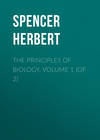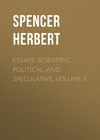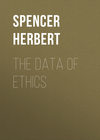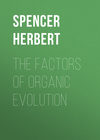Kitabı oku: «The Principles of Biology, Volume 1 (of 2)»
PREFACE TO THE REVISED AND ENLARGED EDITION
Rapid in all directions, scientific progress has during the last generation been more rapid in the direction of Biology than in any other; and had this work been one dealing with Biology at large, the hope of bringing it up to date could not have been rationally entertained. But it is a work on the Principles of Biology; and to bring an exposition of these up to date, seemed not impossible with such small remnant of energy as is left me. Slowly, and often interrupted by ill-health, I have in the course of the last two years, completed this first volume of the final edition.
Numerous additions have proved needful. What was originally said about vital changes of matter has been supplemented by a chapter on "Metabolism." Under the title "The Dynamic Element in Life," I have added a chapter which renders less inadequate the conception of Life previously expressed. A gap in preceding editions, which should have been occupied by some pages on "Structure," is now filled up. Those astonishing actions in cell-nuclei which the microscope has of late revealed, will be found briefly set forth under the head of "Cell-Life and Cell-Multiplication." Further evidence and further thought have resulted in a supplementary chapter on "Genesis, Heredity, and Variation"; in which certain views enunciated in the first edition are qualified and developed. Various modern ideas are considered under the title "Recent Criticisms and Hypotheses." And the chapter on "The Arguments from Embryology" has been mainly rewritten. Smaller increments have taken the shape of new sections incorporated in pre-existing chapters. They are distinguished by the following section-marks: —§ 8a, § 46a, § 87a, § 100a, § 113a, § 127a, §§ 130a-130d. There should also be mentioned a number of foot-notes of some significance not present in preceding editions. Of the three additional appendices the two longer ones have already seen the light in other shapes.
After these chief changes have now to be named the changes necessitated by revision. In making them assistance has been needful. Though many of the amendments have resulted from further thought and inquiry, a much larger number have been consequent on criticisms received from gentlemen whose aid I have been fortunate enough to obtain: each of them having taken a division falling within the range of his special studies. The part concerned with Organic Chemistry and its derived subjects, has been looked through by Mr. W. H. Perkin, Ph.D., F.R.S., Professor of Organic Chemistry, Owens College, Manchester. Plant Morphology and Physiology have been overseen by Mr. A. G. Tansley, M.A., F.L.S., Assistant Professor of Botany, University College, London. Criticisms upon parts dealing with Animal Morphology, I owe to Mr. E. W. MacBride, M.A., Fellow of St. John's College, Cambridge, Professor of Zoology in the McGill University, Montreal, and Mr. J. T. Cunningham, M.A., late Fellow of University College, Oxford. And the statements included under Animal Physiology have been checked by Mr. W. B. Hardy, M.A., Fellow of Gonville and Caius College, Cambridge, Demonstrator of Physiology in the University. Where the discoveries made since 1864 have rendered it needful to change the text, either by omissions or qualifications or in some cases by additions, these gentlemen have furnished me with the requisite information.
Save in the case of the preliminary portion, bristling with the technicalities of Organic Chemistry (including the pages on "Metabolism"), I have not submitted the proofs, either of the new chapters or of the revised chapters, to the gentlemen above named. The abstention has resulted partly from reluctance to trespass on their time to a greater extent than was originally arranged, and partly from the desire to avoid complicating my own work. During the interval occupied in the preparation of this volume the printers have kept pace with me, and I have feared adding to the entailed attention the further attention which correspondence and discussion would have absorbed: feeling that it was better to risk minor inaccuracies than to leave the volume unfinished: an event which at one time appeared probable. I make this statement because, in its absence, one or other of these gentlemen might be held responsible for some error which is not his but mine.
Yet another explanation is called for. Beyond the exposition of those general truths constituting the Principles of Biology as commonly accepted, the original edition of this work contained sundry views for which biological opinion did not furnish any authority. Some of these have since obtained a certain currency; either in their original forms or in modified forms. Misinterpretations are likely to result. Readers who have met with them in other works may, in the absence of warning, suppose, to my disadvantage, that I have adopted them without acknowledgment. Hence it must be understood that where no indication to the contrary is given the substance is unchanged. Beyond the corrections which have been made in the original text, there are, in some cases, additions to the evidence or amplifications of the argument; but in all sections not marked as new, the essential ideas set forth are the same as they were in the original edition of 1864.
Brighton,August, 1898.
PREFACE
The aim of this work is to set forth the general truths of Biology, as illustrative of, and as interpreted by, the laws of Evolution: the special truths being introduced only so far as is needful for elucidation of the general truths.
For aid in executing it, I owe many thanks to Prof. Huxley and Dr. Hooker. They have supplied me with information where my own was deficient;1 and, in looking through the proof-sheets, have pointed out errors of detail into which I had fallen. By having kindly rendered me this valuable assistance, they must not, however, be held committed to any of the enunciated doctrines that are not among the recognized truths of Biology.
The successive instalments which compose this volume, were issued to the subscribers at the following dates: – No. 7 (pp. 1-80) in January, 1863; No. 8 (pp. 81-160) in April, 1863; No. 9 (pp. 161-240) in July, 1863; No. 10 (pp. 241-320) in January, 1864; No. 11 (pp. 321-400) in May, 1864; and No. 12 (pp. 401-476) in October, 1864.
London, September 29th, 1864.
PART I.
THE DATA OF BIOLOGY
CHAPTER I.
ORGANIC MATTER
§ 1. Of the four chief elements which, in various combinations, make up living bodies, three are gaseous under all ordinary conditions and the fourth is a solid. Oxygen, hydrogen, and nitrogen are gases which for many years defied all attempts to liquefy them, and carbon is a solid except perhaps at the extremely high temperature of the electric arc. Only by intense pressures joined with extreme refrigerations have the three gases been reduced to the liquid form.2 There is much significance in this. When we remember how those redistributions of Matter and Motion which constitute Evolution, structural and functional, imply motions in the units that are redistributed; we shall see a probable meaning in the fact that organic bodies, which exhibit the phenomena of Evolution in so high a degree, are mainly composed of ultimate units having extreme mobility. The properties of substances, though destroyed to sense by combination, are not destroyed in reality. It follows from the persistence of force, that the properties of a compound are resultants of the properties of its components —resultants in which the properties of the components are severally in full action, though mutually obscured. One of the leading properties of each substance is its degree of molecular mobility; and its degree of molecular mobility more or less sensibly affects the molecular mobilities of the various compounds into which it enters. Hence we may infer some relation between the gaseous form of three out of the four chief organic elements, and that comparative readiness displayed by organic matters to undergo those changes in the arrangement of parts which we call development, and those transformations of motion which we call function.
Considering them chemically instead of physically, it is to be remarked that three out of these four main components of organic matter, have affinities which are narrow in their range and low in their intensity. Hydrogen, it is true, may be made to combine with a considerable number of other elements; but the chemical energy which it shows is scarcely at all shown within the limits of the organic temperatures. Of carbon it may similarly be said that it is totally inert at ordinary heats; that the number of substances with which it unites is not great; and that in most cases its tendency to unite with them is but feeble. Lastly, this chemical indifference is shown in the highest degree by nitrogen – an element which, as we shall hereafter see, plays the leading part in organic changes.
Among the organic elements (including under the title not only the four chief ones, but also the less conspicuous remainder), that capability of assuming different states called allotropism, is frequent. Carbon presents itself in the three unlike conditions of diamond, graphite, and charcoal. Under certain circumstances, oxygen takes on the form in which it is called ozone. Sulphur and phosphorus (both, in small proportions, essential constituents of organic matter) have allotropic modifications. Silicon, too, is allotropic; while its oxide, silica, which is an indispensable constituent of many lower organisms, exhibits the analogue of allotropism – isomerism. No other interpretation being possible we are obliged to regard allotropic change as some change of molecular arrangement. Hence this frequency of its occurrence among the components of organic matter is significant as implying a further kind of molecular mobility.
One more fact, that is here of great interest for us, must be set down. These four elements of which organisms are almost wholly composed, exhibit certain extreme unlikenesses. While between two of them we have an unsurpassed contrast in chemical activity; between one of them and the other three, we have an unsurpassed contrast in molecular mobility. While carbon, until lately supposed to be infusible and now volatilized only in the electric arc, shows us a degree of atomic cohesion greater than that of any other known element, hydrogen, oxygen, and nitrogen show the least atomic cohesion of all elements. And while oxygen displays, alike in the range and intensity of its affinities, a chemical energy exceeding that of any other substance (unless fluorine be considered an exception), nitrogen displays the greatest chemical inactivity. Now on calling to mind one of the general truths arrived at when analyzing the process of Evolution, the probable significance of this double difference will be seen. It was shown (First Principles, § 163) that, other things equal, unlike units are more easily separated by incident forces than like units are – that an incident force falling on units that are but little dissimilar does not readily segregate them; but that it readily segregates them if they are widely dissimilar. Thus, the substances presenting these two extreme contrasts, the one between physical mobilities, and the other between chemical activities, fulfil, in the highest degree, a certain further condition to facility of differentiation and integration.
§ 2. Among the diatomic combinations of the three elements, hydrogen, nitrogen and oxygen, we find a molecular mobility much less than that of these elements themselves; at the same time that it is much greater than that of diatomic compounds in general. Of the two products formed by the union of oxygen with carbon, the first, called carbonic oxide, which contains one atom3 of carbon to one of oxygen (expressed by the symbol CO) is a gas condensible only with great difficulty; and the second, carbonic acid, containing an additional atom of oxygen (CO2) assumes a liquid form also only under a pressure of about forty atmospheres. The several compounds of oxygen with nitrogen, present us with an instructive gradation. Nitrous oxide (N2O), is a gas condensible only under a pressure of some fifty atmospheres; nitric oxide (NO) is a gas which although it has been liquefied does not condense under a pressure of 270 atmospheres at 46.4° F. (8 °C.): the molecular mobility remaining undiminished in consequence of the volume of the united gases remaining unchanged. Nitrogen trioxide (N2O3) is gaseous at ordinary temperatures, but condenses into a very volatile liquid at the zero of Fahrenheit; nitrogen tetroxide (N2O4) is liquid at ordinary temperatures and becomes solid at the zero of Fahrenheit; while nitrogen pentoxide (N2O5) may be obtained in crystals which melt at 85° and boil at 113°. In this series we see, though not with complete uniformity, a decrease of molecular mobility as the weights of the compound molecules are increased. The hydro-carbons illustrate the same general truth still better. One series of them will suffice. Marsh gas (CH4) is gaseous except under great pressure and at very low temperatures. Olefiant gas (C2H4) and ethane (C2H6) may be readily liquefied by pressure. Propane (C3H8) becomes liquid without pressure at the zero of Fahrenheit. Hexane (C5H12) is a liquid which boils at 160°. And the successively higher multiples, heptane (C7H16), octane (C8H18), and nonane (C9H20) are liquids which boil respectively at 210°, 257°, and 302°. Pentadecan (C15H32) is a liquid which boils at 270°, while paraffin-wax, which contains the still higher multiples, is solid. There are three compounds of hydrogen and nitrogen that have been obtained in a free state – ammonia (NH3) is gaseous, but liquefiable by pressure, or by reducing its temperature to -40° F., and it solidifies at -112° F.; hydrazine (NH2– NH2) is liquid at ordinary temperatures, but hydrozoic acid (N3H) has so far only been obtained in the form of a highly explosive gas. In cyanogen, which is composed of carbon and nitrogen, (CN)2, we have a gas that becomes liquid at a pressure of four atmospheres and solid at -30° F. And in paracyanogen, formed of the same proportions of these elements in higher multiples, we have a solid which does not fuse or volatilize at ordinary temperatures. Lastly, in the most important member of this group, water (H2O), we have a compound of two difficultly-condensible gases which assumes both the fluid state and the solid state within ordinary ranges of temperature; while its molecular mobility is still such that its fluid or solid masses are continually passing into the form of vapour, though not with great rapidity until the temperature is raised to 212°.
Considering them chemically, it is to be remarked of these diatomic compounds of the four chief organic elements, that they are, on the average, less stable than diatomic compounds in general. Water, carbonic oxide, and carbonic acid, are, it is true, difficult to decompose. But omitting these, the usual strength of union among the elements of the above-named substances is low considering the simplicity of the substances. With the exception of acetylene and possibly marsh gas, the various hydro-carbons are not producible by directly combining their elements; and the elements of most of them are readily separable by heat without the aid of any antagonistic affinity. Nitrogen and hydrogen do not unite with each other immediately save under very exceptional circumstances; and the ammonia which results from their union, though it resists heat, yields to the electric spark. Cyanogen is stable: not being resolved into its components below a bright red heat. Much less stable, however, are several of the oxides of nitrogen. Nitrous oxide, it is true, does not yield up its elements below a red heat; but nitrogen tetroxide cannot exist if water be added to it; nitrous acid is decomposed by water; and nitric acid not only readily parts with its oxygen to many metals, but when anhydrous, spontaneously decomposes. Here it will be well to note, as having a bearing on what is to follow, how characteristic of most nitrogenous compounds is this special instability. In all the familiar cases of sudden and violent decomposition, the change is due to the presence of nitrogen. The explosion of gunpowder results from the readiness with which the nitrogen contained in the nitrate of potash, yields up the oxygen combined with it. The explosion of gun-cotton, which also contains nitrogen, is a substantially parallel phenomenon. The various fulminating salts are all formed by the union with metals of a certain nitrogenous acid called fulminic acid; which is so unstable that it cannot be obtained in a separate state. Explosiveness is a property of nitro-mannite, and also of nitro-glycerin. Iodide of nitrogen detonates on the slightest touch, and often without any assignable cause. And the bodies which explode with the most tremendous violence of any known, are the chloride of nitrogen (NCl3) and hydrazoic acid (N3H). Thus these easy and rapid decompositions, due to the chemical indifference of nitrogen, are characteristic. When we come hereafter to observe the part which nitrogen plays in organic actions, we shall see the significance of this extreme readiness shown by its compounds to undergo changes. Returning from these facts parenthetically introduced, we have next to note that though among the diatomic compounds of the four chief organic elements, there are a few active ones, yet the majority of them display a smaller degree of chemical energy than the average of diatomic compounds. Water is the most neutral of bodies: usually producing little chemical alteration in the substances with which it combines; and being expelled from most of its combinations by a moderate heat. Carbonic acid is a relatively feeble acid: the carbonates being decomposed by the majority of other acids and by ignition. The various hydro-carbons are but narrow in the range of their comparatively weak affinities. The compounds formed by ammonia have not much stability: they are readily destroyed by heat, and by the other alkalies. The affinities of cyanogen are tolerably strong, though they yield to those of the chief acids. Of the several oxides of nitrogen, it is to be remarked that, while those containing the smaller proportions of oxygen are chemically inert, the one containing the greatest proportion of oxygen (nitric acid) though chemically active, in consequence of the readiness with which one part of it gives up its oxygen to oxidize a base with which the rest combines, is nevertheless driven from all its combinations by a red heat.
These diatomic compounds, like their elements, are to a considerable degree characterized by the prevalence among them of allotropism; or, as it is more usually called when displayed by compound bodies – isomerism. Professor Graham finds reason for thinking that a change in atomic arrangements of this nature, takes place in water, at or near the melting point of ice. In the various series of hydro-carbons, differing from each other only in the ratios in which the elements are united, we find not simply isomerism but polymerism occurring to an almost infinite extent. In some series of hydro-carbons, as, for example, the terpenes, we find isomerism and at the same time a great tendency to undergo polymerisation. And the relation between cyanogen and paracyanogen is, as we saw, a polymeric one.
There is one further fact respecting these diatomic compounds of the chief organic elements, which must not be overlooked. Those of them which form parts of the living tissues of plants and animals (excluding water which has a mechanical function, and carbonic acid which is a product of decomposition) belong for the most part to one group – the carbo-hydrates.4 And of this group, which is on the average characterized by comparative instability and inertness, these carbo-hydrates found in living tissues are among the most unstable and inert.
§ 3. Passing now to the substances which contain three of these chief organic elements, we have first to note that along with the greater atomic weight which mostly accompanies their increased complexity, there is, on the average, a further marked decrease of molecular mobility. Scarcely any of them maintain a gaseous state at ordinary temperatures. One class of them only, the alcohols and their derivatives, evaporate under the usual atmospheric pressure; but not rapidly unless heated. The fixed oils, though they show that molecular mobility implied by an habitually liquid state, show this in a lower degree than the alcoholic compounds; and they cannot be reduced to the gaseous state without decomposition. In their allies, the fats, which are solid unless heated, the loss of molecular mobility is still more marked. And throughout the whole series of the fatty acids, in which to a fixed proportion of oxygen there are successively added higher equimultiples of carbon and hydrogen, we see how the molecular mobility decreases with the increasing sizes of the molecules. In the amylaceous and sugar-group of compounds, solidity is the habitual state: such of them as can assume the liquid form, doing so only when heated to 300° or 400° F.; and decomposing when further heated, rather than become gaseous. Resins and gums exhibit general physical properties of like character and meaning.
In chemical stability these triatomic compounds, considered as a group, are in a marked degree below the diatomic ones. The various sugars and kindred bodies, decompose at no very high temperatures. The oils and fats also are readily carbonized by heat. Resinous and gummy substances are easily made to render up some of their constituents. And the alcohols, with their allies, have no great power of resisting decomposition. These bodies, formed by the union of oxygen, hydrogen, and carbon, are also, as a class, chemically inactive. Formic and acetic are doubtless energetic acids; but the higher members of the fatty-acid series are easily separated from the bases with which they combine. Saccharic acid, too, is an acid of considerable power; and sundry of the vegetable acids possess a certain activity, though an activity far less than that of the mineral acids. But throughout the rest of the group, there is shown but a small tendency to combine with other bodies; and such combinations as are formed have usually little permanence.
The phenomena of isomerism and polymerism are of frequent occurrence in these triatomic compounds. Starch and dextrine are probably polymeric. Fruit-sugar and grape-sugar, mannite and sorbite, cane-sugar and milk-sugar, are isomeric. Sundry of the vegetal acids exhibit similar modifications. And among the resins and gums, with their derivatives, molecular re-arrangements of this kind are not uncommon.
One further fact respecting these compounds of carbon, oxygen and hydrogen, should be mentioned; namely, that they are divisible into two classes – the one consisting of substances that result from the destructive decomposition of organic matter, and the other consisting of substances that exist as such in organic matter. These two classes of substances exhibit, in different degrees, the properties to which we have been directing our attention. The lower alcohols, their allies and derivatives, which possess greater molecular mobility and chemical stability than the rest of these triatomic compounds, are rarely found in animal or vegetal bodies. While the sugars and amylaceous substances, the fixed oils and fats, the gums and resins, which have all of them much less molecular mobility, and are, chemically considered, more unstable and inert, are components of the living tissues of plants and animals.
§ 4. Among compounds containing all the four chief organic elements, a division analogous to that just named may be made. There are some which result from the decomposition of living tissues; there are others which make parts of living tissues in their state of integrity; and these two groups are contrasted in their properties in the same way as are the parallel groups of triatomic compounds.
Of the first division, certain products found in the animal excretions are the most important, and the only ones that need be noted; such, namely, as urea, kreatine, kreatinine. These animal-bases exhibit much less molecular mobility than the average of the substances treated of in the last section: being solid at ordinary temperatures, fusing, where fusible at all, at temperatures above that of boiling water, and having no power to assume a gaseous state. Chemically considered, their stability is low, and their activity but small, in comparison with the stabilities and activities of the simpler compounds.
It is, however, the nitrogenous constituents of living tissues, that display most markedly those characteristics of which we have been tracing the growth. Albumen, fibrin, casein, and their allies, are bodies in which that molecular mobility exhibited by three of their components in so high a degree is reduced to a minimum. These substances are known only in the solid state. That is to say, when deprived of the water usually mixed with them, they do not admit of fusion, much less of volatilization. To which add, that they have not even that molecular mobility which solution in water implies; since, though they form viscid mixtures with water, they do not dissolve in the same perfect way as do inorganic compounds. The chemical characteristics of these substances are instability and inertness carried to the extreme. How rapidly albumenoid matters decompose under ordinary conditions, is daily seen: the difficulty of every housewife being to prevent them from decomposing. It is true that when desiccated and kept from contact with air, they may be preserved unchanged for long periods; but the fact that they can be only thus preserved, proves their great instability. It is true, also, that these most complex nitrogenous principles are not absolutely inert, since they enter into combinations with some bases; but their unions are very feeble.
It should be noted, too, of these bodies, that though they exhibit in the lowest degree that kind of molecular mobility which implies facile vibration of the molecules as wholes, they exhibit in high degrees that kind of molecular mobility resulting in isomerism, which implies permanent changes in the positions of adjacent atoms with respect to each other. Each of them has a soluble and an insoluble form. In some cases there are indications of more than two such forms. And it appears that their metamorphoses take place under very slight changes of conditions.
In these most unstable and inert organic compounds, we find that the molecular complexity reaches a maximum: not only since the four chief organic elements are here united with small proportions of sulphur and sometimes phosphorus; but also since they are united in high multiples. The peculiarity which we found characterized even diatomic compounds of the organic elements, that their molecules are formed not of single equivalents of each component, but of two, three, four, and more equivalents, is carried to the greatest extreme in these compounds, which take the leading part in organic actions. According to Lieberkühn, the formula of albumen is C72H112SN18O22. That is to say, with the sulphur there are united seventy-two atoms of carbon, one hundred and twelve of hydrogen, eighteen of nitrogen, and twenty-two of oxygen: the molecule being thus made up of more than two hundred ultimate atoms.
§ 5. Did space permit, it would be useful here to consider in detail the interpretations that may be given of the peculiarities we have been tracing: bringing to their solution, the general mechanical principles which are now found to hold true of molecules as of masses. But it must suffice briefly to indicate the conclusions which such an inquiry promises to bring out.
Proceeding on these principles, it may be argued that the molecular mobility of a substance must depend partly on the inertia of its molecules; partly on the intensity of their mutual polarities; partly on their mutual pressures, as determined by the density of their aggregation; and (where the molecules are compound) partly on the molecular mobilities of their component molecules. Whence it is to be inferred that any three of these remaining constant, the molecular mobility will vary as the fourth. Other things equal, therefore, the molecular mobility of molecules must decrease as their masses increase; and so there must result that progression we have traced, from the high molecular mobility of the uncombined organic elements, to the low molecular mobility of those large-moleculed substances into which they are ultimately compounded.
Applying to molecules the mechanical law which holds of masses, that since inertia and gravity increase as the cubes of the dimensions while cohesion increases as their squares, the self-sustaining power of a body becomes relatively smaller as its bulk becomes greater; it might be argued that these large, aggregate molecules which constitute organic substances, are mechanically weak – are less able than simpler molecules to bear, without alteration, the forces falling on them. That very massiveness which renders them less mobile, enables the physical forces acting on them more readily to change the relative positions of their component atoms; and so to produce what we know as re-arrangements and decompositions.
Further, it seems a not improbable conclusion, that this formation of large aggregates of elementary atoms and resulting diminution of self-sustaining power, must be accompanied by a decrease of those dimensional contrasts to which polarity is ascribable. A sphere is the figure of equilibrium which any aggregate of units tends to assume, under the influence of simple mutual attraction. Where the number of units is small and their mutual polarities are decided, this proclivity towards spherical grouping will be overcome by the tendency towards some more special form, determined by their mutual polarities. But it is manifest that in proportion as an aggregate molecule becomes larger, the effects of simple mutual attraction must become relatively greater; and so must tend to mask the effects of polar attraction. There will consequently be apt to result in highly compound molecules like these organic ones, containing hundreds of elementary atoms, such approximation to the spherical form as must involve a less distinct polarity than in simpler molecules. If this inference be correct, it supplies us with an explanation both of the chemical inertness of these most complex organic substances, and of their inability to crystallize.
Wishing in this, as in other cases, to acknowledge indebtedness when conscious of it, I introduced the words referred to, in recognition of the fact that I had repeatedly questioned the distinguished specialists named, on matters beyond my knowledge, which were not dealt with in the books at my command. Forgetting the habits of antagonists, and especially theological antagonists, it never occurred to me that my expression of thanks to my friends for "information where my own was deficient," would be turned into the sweeping statement that I was indebted to them for my facts.
Had Professor Watts looked at the preface to the second volume (the two having been published separately, as the prefaces imply), he would have seen a second expression of my indebtedness "for their valuable criticisms, and for the trouble they have taken in checking the numerous statements of fact on which the arguments proceed" – no further indebtedness being named. A moment's comparison of the two volumes in respect of their accumulations of facts, would have shown him what kind of warrant there was for his interpretation.
Doubtless the Rev. Professor was prompted to make this assertion by the desire to discredit the work he was attacking; and having so good an end in view, thought it needless to be particular about the means. In the art of dealing with the language of opponents, Dr. Watts might give lessons to Monsignor Capel and Archbishop Manning.
December 28th, 1874.



















